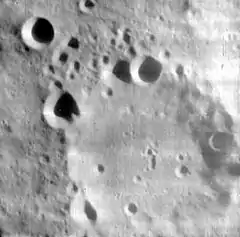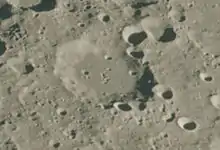 Lunar Orbiter 4 image | |
| Coordinates | 63°54′S 75°54′E / 63.9°S 75.9°E |
|---|---|
| Diameter | 66 km |
| Depth | Unknown |
| Colongitude | 286° at sunrise |
| Eponym | David Gill |

Gill is a lunar impact crater that is located near the southeastern limb of the Moon. Due to its proximity to the edge of the Moon as seen from the Earth, this crater is viewed nearly from the side and it can become hidden from sight due to libration. The crater lies to the southwest of the irregular Mare Australe, and southeast of the prominent crater Pontécoulant. To the southwest of Gill is the crater Helmholtz.
This is an old, eroded crater formation with an outer rim that is uneven from a history of impacts. A joined pair of small craters lie along the northern rim, and Gill A intrudes slightly into the western outer rim. The interior floor is relatively level, and is marked by several craterlets.
On June 11, 2009, the Japanese SELENE lunar orbiter spacecraft was deliberately crashed into the surface of the Moon to the southeast of Gill. The impact site was at selenographic coordinates 65.5 S, 80.4 E.[1] The flash from the impact was successfully observed from Mount Abu Observatory in Guru Shikhar, India.[2] and by the Anglo-Australian Telescope.[3]
Satellite craters
By convention these features are identified on lunar maps by placing the letter on the side of the crater midpoint that is closest to Gill.
| Gill | Latitude | Longitude | Diameter (km) | Diameter (mi) |
|---|---|---|---|---|
| A | 63.6° S | 72.9° E | 13 km | 8 mi |
| B | 61.7° S | 69.9° E | 31 km | 19 mi |
| C | 62.2° S | 67.4° E | 30 km | 19 mi |
| D | 63.4° S | 79.8° E | 15 km | 9 mi |
| E | 63.3° S | 70.4° E | 13 km | 8 mi |
| F | 63.8° S | 65.1° E | 23 km | 14 mi |
| G | 63.5° S | 68.2° E | 32 km | 20 mi |
| H | 63.9° S | 70.2° E | 8 km | 5 mi |
References
- ↑ "KAGUYA (SELENE) Slam Crashed to the Moon". Japan Aerospace Exploration Agency. June 11, 2009. Archived from the original on 2013-04-28. Retrieved 2009-06-29.
- ↑ "Impact of Japanese spacecraft Kaguya (Selene) on lunar surface". European Space Agency. June 17, 2009. Retrieved 2009-06-29.
- ↑ "AAO Newsletter August 2009" (PDF). Anglo Australian Observatory. August 31, 2009. Archived from the original (PDF) on 2009-10-01. Retrieved 2009-10-11.
General references
- Andersson, L. E.; Whitaker, E. A. (1982). NASA Catalogue of Lunar Nomenclature. NASA RP-1097.
- Blue, Jennifer (July 25, 2007). "Gazetteer of Planetary Nomenclature". USGS. Retrieved 2007-08-05.
- Bussey, B.; Spudis, P. (2004). The Clementine Atlas of the Moon. New York: Cambridge University Press. ISBN 978-0-521-81528-4.
- Cocks, Elijah E.; Cocks, Josiah C. (1995). Who's Who on the Moon: A Biographical Dictionary of Lunar Nomenclature. Tudor Publishers. ISBN 978-0-936389-27-1.
- McDowell, Jonathan (July 15, 2007). "Lunar Nomenclature". Jonathan's Space Report. Retrieved 2007-10-24.
- Menzel, D. H.; Minnaert, M.; Levin, B.; Dollfus, A.; Bell, B. (1971). "Report on Lunar Nomenclature by the Working Group of Commission 17 of the IAU". Space Science Reviews. 12 (2): 136–186. Bibcode:1971SSRv...12..136M. doi:10.1007/BF00171763. S2CID 122125855.
- Moore, Patrick (2001). On the Moon. Sterling Publishing Co. ISBN 978-0-304-35469-6.
- Price, Fred W. (1988). The Moon Observer's Handbook. Cambridge University Press. ISBN 978-0-521-33500-3.
- Rükl, Antonín (1990). Atlas of the Moon. Kalmbach Books. ISBN 978-0-913135-17-4.
- Webb, Rev. T. W. (1962). Celestial Objects for Common Telescopes (6th revised ed.). Dover. ISBN 978-0-486-20917-3.
- Whitaker, Ewen A. (1999). Mapping and Naming the Moon. Cambridge University Press. ISBN 978-0-521-62248-6.
- Wlasuk, Peter T. (2000). Observing the Moon. Springer. ISBN 978-1-85233-193-1.
External links
- Wood, Chuck (November 28, 2007). "Full Res!". Lunar Photo of the Day. Archived from the original on 2011-05-17. Retrieved 2007-11-28.